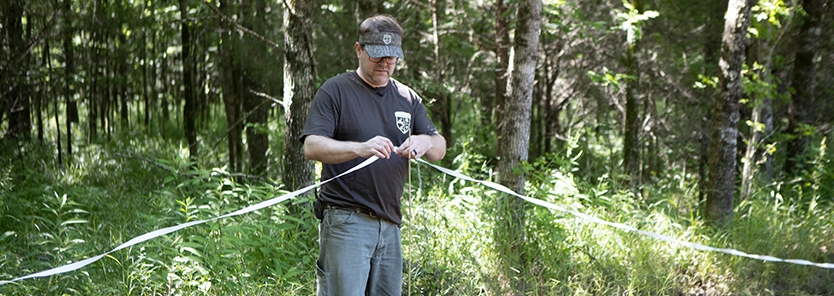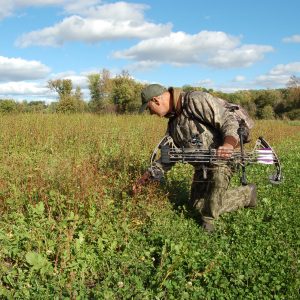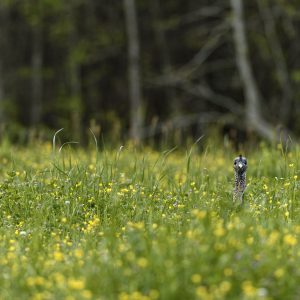Food Plot Fencing and Tactics to Protect from Overbrowsing
Use these Food Plot Fencing and other Tactics to help establish and protect against over-browsing in your food plots:
- Add a nurse or cover crop
Including another food plant that is also attractive or a cover source that grows taller and helps shield the lower growing plants can help deflect pressure. Planting oats or wheat with clover is a prime example. However, this is an annual protecting a perennial. When it comes to brassicas, or annuals protecting annuals, it’s not necessarily that simple. Some-times providing an annual that is more attractive earlier can take some pressure off of the brassicas so they can reach the pinnacle of their production and really begin to pump out the tonnage. Cereal grains with brassicas would be an example. But in this case we’d be taking away precious acreage from brassicas if we added cereal grains. It would be easy with more acreage to plant. It could just be that they are eating your brassicas too early so they never reach what I refer to as “terminal yield,” the point at about 3 to 4 weeks after germination when the brassicas really start to gain momentum and put on big yield. So the following additional tips are geared more towards protecting the forage so it can make it to this point. - Milorganite Fertilizer
Milorganite fertilizer is made from bio-solids left after processing sewage sludge. It really doesn’t smell as bad as you may think, but deer hate it. It can lose its sting after a while, but after the initial application it has fair success at repealing whitetails. The University of Georgia tested Milorganite-treated soybean plots against untreated ones and found after three days, 54% of untreated plants were browsed while only 24% of those treated with Milorganite were browsed. At day 20, the proportion was 59% of the treated plants were hit, versus 99% untreated. So if you want longer effectiveness, it’s recommended to re-apply after 15 days. - BioLogic’s P2 Plot Protector Kit
BioLogic’s P2 Plot Protector Kit includes enough ribbon to go around an entire acre (or two ¼ acre plots) and enough formula to treat it for 90 days (each also sold separately). This system is economical and works well. It is suggested to erect one strand at 30 inches high and another one at 15 inches off the ground. The P2 kit won’t solve your problem of too many deer, but it can help protect the plot to help it reach a more established age when it will last you longer into the season. - Temporary Fences
Temporary fences can dissuade activity for a short while. Or, depending upon how strong and complete you build it, keep deer out completely forever. The mesh or strands need to be tight enough so they can’t squeeze through and tall enough so they can’t jump over. A wire or poly mesh bottom at least 4 feet high is a good start, and then either another section of mesh on top of that, or strands of wire, rope, twine or ribbon strung above that to give the appearance it’s too high to jump over. Poly mesh products 7 or 8 feet tall are available relatively inexpensive; however, for large food plots it’s very labor intensive. - Well Designed Electric Fence
A well designed electric fence is the most effective and efficient method for keeping deer out of a food plot. If a manager has the permanent problem of too many mouths and not enough food plot acreage, an electric fence is the best solution. They are a bit more expensive than our other choices, but they are also most effective. While a single strand may work for a while, a staggered two or three wire perimeter will keep out everything from whitetails to hogs and bears. The staggered method gives both, the obvious electric shock and the confusion of depth-perception difficulty. Unless you’re going to fence off the entire plot in a “zoo-quality” wire enclosure, electric fencing is the best permanent solution.
Todd Amenrud is Director of Public Relations for BioLogic and Editor in Chief for Gamekeepers-Farming for Wildlife magazine. Austin Delano is BioLogic’s Southern Field Services Manager and Head of Research & Development. If you would like to ask either of them a question about whitetails, planting food plots, or managing other game animals you may contact them at tamenrud@mossyoak.com or adelano@mossyoak.com.
~
For more from GameKeeper Farming For Wildlife like Food Plot Fencing and Tactics to Protect Plots join our weekly newsletter or subscribe to GameKeepers Magazine. Your source for information, equipment, know-how, deals and discounts to help you get the most from every hard-earned moment in the field.






